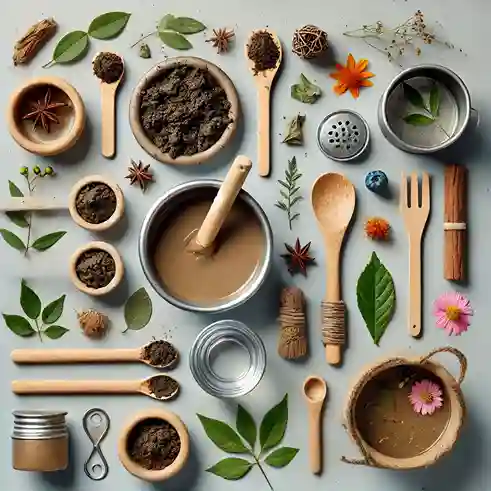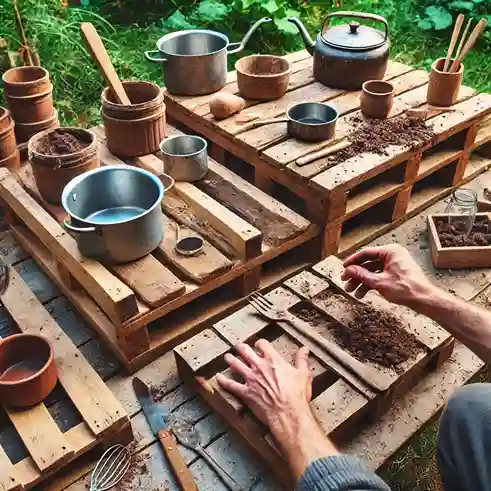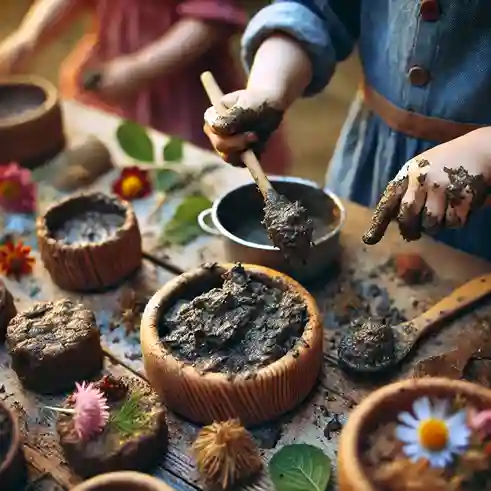Mud kitchens have taken the world of outdoor play by storm, providing children with endless opportunities to explore, create, and engage in sensory activities. But if you’re new to the concept, you might be wondering: what is a mud kitchen, and why is it so important for children’s development?
In this comprehensive guide, we will explore what mud kitchens are, why they are beneficial for kids, how to build your own, and why they are becoming an essential part of outdoor play for families across the globe. Whether you are a parent, teacher, or childcare provider, this guide will give you all the information you need to understand and create the perfect mud kitchen for your children.
1. What Is a Mud Kitchen?
What is A mud kitchen is essentially an outdoor play area that mimics the functionality of a real kitchen, where children use mud, water, and other natural materials to pretend they are cooking. This type of outdoor play space is often made from natural or recycled materials and includes a variety of play components like sinks, countertops, shelves, and storage compartments for “ingredients” such as dirt, leaves, flowers, and sand.
Children can mix mud, water, and other natural materials in bowls, pots, and pans, pretending they are creating recipes. The beauty of a mud kitchen lies in its simplicity and adaptability—no two mud kitchens are the same. They can be as basic or as elaborate as you choose, with endless customization possibilities to match your child’s interests.
What is a Mud kitchen encourage open-ended play and are considered an important tool for sensory exploration. The process of touching, mixing, and molding mud is not only fun but also a rich sensory experience that helps develop motor skills, cognitive abilities, and problem-solving techniques.

2. Why Are Mud Kitchens Important for Kids’ Development?
What is a Mud kitchen offer children a chance to engage in active, creative, and messy play, which is essential for healthy development. Here are some of the key developmental benefits associated with mud kitchens:
A. What is a mud kitchen Sensory Development
What is a Mud kitchen engage children in a full-body sensory experience. By handling materials with different textures—mud, water, sand, leaves—children activate their senses and fine-tune their sense of touch. This type of tactile stimulation is important for developing fine motor skills and hand-eye coordination.
B.What is a mud kitchen Imaginative and Role Play
When children pretend to be chefs, bakers, or even construction workers mixing cement, they are engaging in imaginative role-play. This type of play fosters creativity and allows children to explore new roles and scenarios. Whether they’re creating mud pies, soups, or cakes, they’re using their imagination to think outside the box.
C. What is a mud kitchen Social Skills and Teamwork
If there’s one thing that mud kitchens excel at, it’s encouraging collaborative play. Children often play together in mud kitchens, learning how to share tools, work as a team, and communicate their ideas. This not only helps build social skills but also promotes problem-solving and cooperation.
D.What is a mud kitchen Emotional and Physical Development
Messy play allows children to express their emotions through hands-on activities. Sinking their hands into mud, splashing water, and creating mixtures can be incredibly therapeutic, helping kids release pent-up energy and frustration. Additionally, the physical movements involved in mud kitchen play—such as stirring, scooping, pouring, and digging—help children develop their gross and fine motor skills.
E.What is a mud kitchen Independence and Self-Confidence
As children navigate the various tasks in their mud kitchen, they develop a sense of independence. Whether they’re deciding what to cook, how to mix ingredients, or where to find materials, they are learning how to make decisions on their own. Completing these tasks successfully builds self-confidence, as they feel a sense of accomplishment from creating something tangible and unique.

3. The Evolution of Mud Kitchens: From Simple Play to Creative Exploration
Mud kitchens may seem like a recent trend, but the concept of playing with mud and dirt has been around for centuries. In many cultures, children have traditionally engaged in outdoor, messy play that allows them to connect with nature and use their imaginations. The difference today is that modern what is a mud kitchen are designed to replicate a kitchen environment, making them more structured and purposeful than the informal mud play of the past.
A. Traditional Mud Play
In the past, children would play with dirt, make mud pies, and construct makeshift “kitchens” out of natural elements like stones, sticks, and leaves. This type of play was often spontaneous and unstructured, allowing children to explore their surroundings without the confines of toys or pre-built playsets. However, this type of play has gradually disappeared in many parts of the world due to the rise of indoor entertainment and technology.
B. What is a mud kitchen Modern ?
The modern mud kitchen has revived this tradition of outdoor play, but with added structure and focus. Today’s mud kitchens often include:
- Wooden frames that mimic real kitchen counters and sinks.
- Shelves and storage spaces for utensils, pots, and pans.
- Running water or basins for easy mud mixing.
- Creative elements like chalkboards for writing down “recipes” or signs with children’s names.
These modern versions are a blend of DIY creativity and practicality, offering children a more defined space to engage in imaginative play while encouraging eco-friendly practices by using upcycled materials.
C. Why Parents Love Mud Kitchens
Parents love mud kitchens because they get kids outside and away from screens. In a world where children spend increasingly more time indoors, mud kitchens offer an opportunity to reconnect with nature. The environmental benefits are also appealing; many mud kitchens are made from recycled or sustainable materials, allowing parents to teach their kids about the importance of reusing and reducing waste.

4. How to Build a Mud Kitchen: DIY Ideas and Tips
If you’re excited about the idea of a What is a mud kitchen but don’t want to spend a fortune on a pre-made one, consider building your own. Building a mud kitchen is not as difficult as it may seem, and it’s a fun project that can be customized to fit your child’s interests.
A.What is a mud kitchen Step-by-Step Guide to Building a DIY Mud Kitchen
Step 1: Gather Materials
You can build a mud kitchen using materials you already have around the house, or you can buy simple, inexpensive materials from a hardware store. Common materials include:
- Wooden pallets or old furniture for the frame.
- Plastic tubs or old sinks for water basins.
- Shelves for storing utensils, bowls, and other tools.
- Hooks for hanging kitchen utensils.
You can get creative by upcycling old furniture, like a worn-out table, bookshelf, or cabinets.
Step 2: Assemble the Frame
Start by building a sturdy frame for your mud kitchen. You can do this by stacking wooden pallets or using an old table as the base. The frame should be at a comfortable height for your child to stand and play.
Step 3: Add the Sink or Water Basin
The next step is to add a sink or water basin. If you have an old sink lying around, this is the perfect time to reuse it. If not, a simple plastic tub will work just as well. Secure the tub or sink to the counter space, so it doesn’t move when children are pouring or stirring water.
Step 4: Install Shelves and Storage
Add some shelves or storage compartments where your child can store kitchen utensils, bowls, and other items. You can make shelves out of spare wood or even use old crates or bins for this purpose.
Step 5: Personalize and Decorate
Once the main structure is in place, let your child personalize the What is a mud kitchen mud kitchen by adding their favorite colors, names, or signs. Use chalkboard paint to create a space where your child can write down “recipes” or instructions. You can also hang a sign that says “[Your Child’s Name]’s Mud Kitchen” for a special touch.
5. Essential Features of What is a mud kitchen
Now that you know how to build a mud kitchen, let’s explore the essential features that make it a fun and functional play area for kids. Whether you’re building your own or buying one, here are the elements to include:
A. Work Surface
A sturdy work surface is essential for a mud kitchen. This is where kids will mix their mud, water, and other materials, so it needs to be durable and easy to clean. Choose a waterproof surface if possible, or paint the wood with a weather-resistant finish.
B. Sink or Water Basin
One of the most important features of a mud kitchen is a sink or water basin. This is where children will mix water with mud to create their concoctions. If you’re building your own mud kitchen, a plastic tub can serve as the water basin, or you can install an old sink for a more realistic feel.
C. Shelving and Storage
Children need space to store their utensils, pots, pans, and other accessories. Adding shelves or hooks gives them a place to organize their tools, teaching them how to manage their play space effectively.
D. Utensils and Tools
Mud kitchens are all about creativity, and the right tools can enhance that experience. Stock your mud kitchen with child-safe kitchen tools like wooden spoons, plastic pots and pans, ladles, and measuring cups. You can find these items at thrift stores or repurpose old kitchen supplies.
E. Natural Elements
Mud kitchens are all about connecting with nature, so be sure to include plenty of natural elements in your play space. Add rocks, leaves, pinecones, flowers, and even small twigs or branches that children can use in their pretend cooking. These materials encourage creativity and provide endless possibilities for imaginative play.
F. Chalkboard or Recipe Board
Adding a chalkboard or recipe board is a fun way to encourage learning while playing. Children can write down their pretend recipes, keep track of ingredients, or simply doodle. This also encourages early writing skills in younger children.
6. What is a mud kitchen Ideas for 2024
If you’re looking for some inspiration before building or buying a mud kitchen, here are some of the most popular mud kitchen ideas for 2024. These designs range from simple and rustic to more elaborate setups, but they all encourage creative outdoor play.
A. Rustic Wooden Mud Kitchen
This type of mud kitchen uses reclaimed wood to create a natural, rustic look. You can build the frame out of old wooden pallets and paint it with weather-resistant paint. Add wooden shelves, hooks for hanging tools, and a wooden work surface. This eco-friendly option blends seamlessly with outdoor surroundings and encourages sustainable play.
B. Nature-Integrated Mud Kitchen
For families who love nature, a nature-integrated mud kitchen is the way to go. Surround the kitchen with plants, rocks, and natural elements that children can incorporate into their play. You can even plant a small herb garden nearby, so kids can “harvest” their own ingredients for their pretend meals. This kitchen is perfect for blending outdoor play with gardening and nature exploration.
C. Mobile Mud Kitchen
If you don’t have a permanent outdoor space, a mobile What is a mud kitchen might be the perfect solution. Built on wheels, this kitchen can be moved around the yard or brought indoors when the weather is bad. It’s also a great space-saving option for families with smaller backyards or patios.
D. Upcycled Mud Kitchen
One of the most popular mud kitchen trends in 2024 is the upcycled mud kitchen. This type of kitchen is made entirely from reused or repurposed materials. Old furniture like a dresser, desk, or kitchen cabinet can be turned into a mud kitchen with a little creativity. You can cut holes for sinks, add shelves, and attach hooks for utensils. Not only is this an eco-friendly option, but it also teaches children the importance of reusing materials.
7. What is a mud kitchen Play Ideas to Engage Kids
Once your mud kitchen is set up, it’s time for the fun to begin. But if you want to keep things interesting, here are some engaging play ideas to spark your child’s imagination:
A. Mud Pies and Cakes
Encourage your child to make mud pies and cakes using mud, water, and natural materials like leaves, flowers, and stones. Provide them with different-sized bowls, cake pans, and spoons to enhance their creativity.
B. Outdoor Potion Making
Kids love making potions, and a mud kitchen is the perfect place to mix all kinds of “magic” ingredients. Use water, mud, leaves, sticks, and flowers to create magical potions. You can even add a touch of food coloring to the water for added fun.
C. Sensory Exploration
For younger children, sensory exploration is key. Provide them with different textures and materials like wet mud, dry dirt, leaves, and sand to explore. Ask them to describe how each material feels—whether it’s gritty, smooth, or rough. This type of play enhances their vocabulary while developing their sensory awareness.
D. Mud Cooking Challenges
Create fun cooking challenges for older kids, where they have to make a “meal” using specific natural ingredients. You can give them a set of “mystery ingredients” like rocks, sand, and leaves, and challenge them to come up with a creative recipe.
E. Outdoor Cafe or Restaurant
Set up an outdoor cafe or restaurant using the mud kitchen. Children can pretend to be chefs or waiters, taking orders from family members and “cooking” their meals. This role-play scenario encourages social skills, communication, and imaginative thinking.
8. Frequently Asked Questions About What is a mud kitchen
Q:What is a mud kitchen, What age is appropriate for a mud kitchen?
Mud kitchens are generally best suited for children aged 2 to 8 years old, but older kids can also enjoy the creative and sensory aspects of outdoor play. The setup can be adjusted depending on the child’s age to make it more challenging or easier to use.
Q:What is a mud kitchen How do I keep a mud kitchen clean?
While mud kitchens are inherently messy, regular maintenance can keep the space from getting out of hand. Clean off the work surfaces after play by rinsing them with a garden hose. Consider adding a drainage system under the sink or basin to make cleaning easier. You can also store the utensils in a waterproof bin to prevent dirt buildup when not in use.
Q:What is a mud kitchen Is it safe for kids?
Yes, mud kitchens are generally safe for children, especially when made with kid-friendly materials. Make sure the kitchen is sturdy and there are no sharp edges on any tools or surfaces. It’s also important to supervise young children while they play to ensure they are using the space safely.
Q:What is a mud kitchen How do I make a mud kitchen more sustainable?
To make your mud kitchen more sustainable, use upcycled materials like old furniture, pallets, or household items you no longer need. You can also source natural materials like rocks, branches, and leaves from your backyard to reduce waste. Incorporating plants and herbs into the kitchen encourages kids to connect with nature while learning about eco-friendly practices.
9. Final Thoughts: Why Every Child Should Have a Mud Kitchen What is a mud kitchen
A mud kitchen is not just a fun outdoor activity—it’s a powerful tool for child development, promoting creativity, social interaction, and physical activity. By offering children the chance to engage in sensory play, connect with nature, and use their imagination, mud kitchens help kids grow in ways that indoor toys simply can’t.
Parents love What is a mud kitchen mud kitchens because they offer an easy, cost-effective way to get kids outdoors and away from screens. With a little creativity and some basic materials, you can build a mud kitchen that will provide hours of fun and learning for your child.
Conclusion What is a mud kitchen:
A mud kitchen is a valuable addition to any backyard or outdoor play area. Whether you build your own or buy a pre-made one, the benefits for your child’s development are endless. So roll up your sleeves, grab some mud, and get ready for some messy, imaginative fun!

